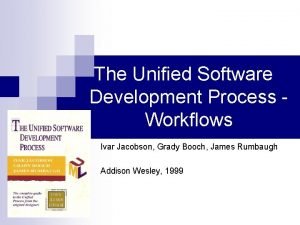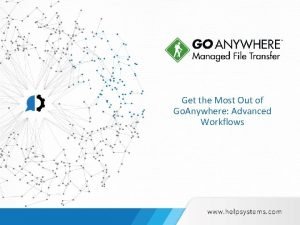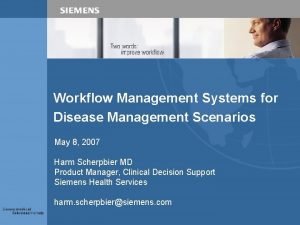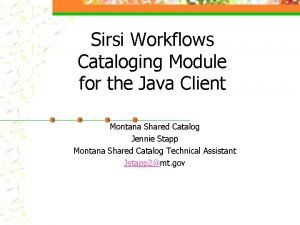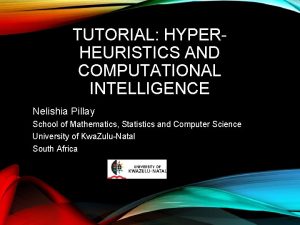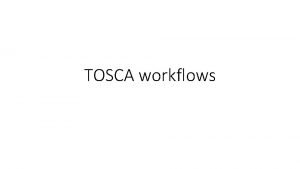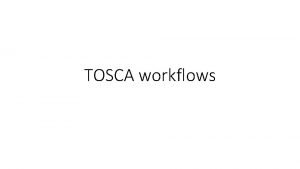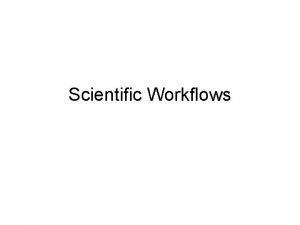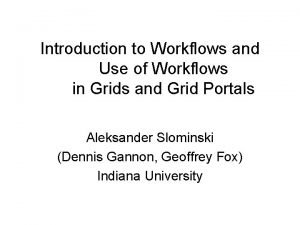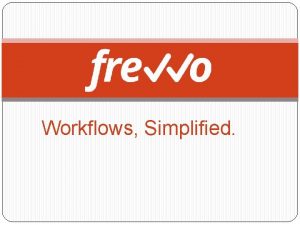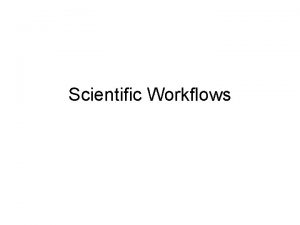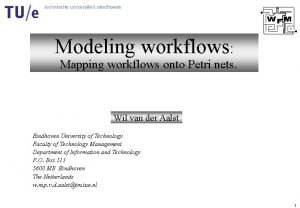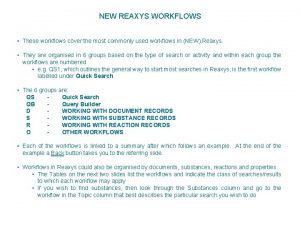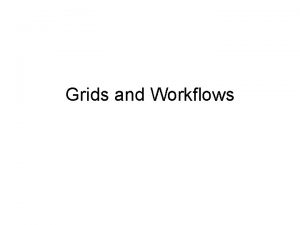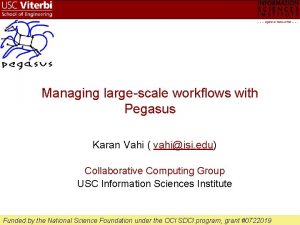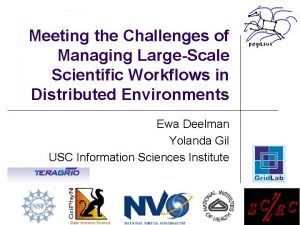AAAI08 Tutorial on Computational Workflows for LargeScale Artificial














![Montage [Deelman et al 05] Small 1, 200 Montage W Montage application ~7, 000 Montage [Deelman et al 05] Small 1, 200 Montage W Montage application ~7, 000](https://slidetodoc.com/presentation_image_h2/6e7de0da119baabbc1809188d0846a6e/image-15.jpg)

![Pegasus: Scale [Deelman et al 06] SCEC workflows run each week using Pegasus and Pegasus: Scale [Deelman et al 06] SCEC workflows run each week using Pegasus and](https://slidetodoc.com/presentation_image_h2/6e7de0da119baabbc1809188d0846a6e/image-17.jpg)
- Slides: 17

AAAI-08 Tutorial on Computational Workflows for Large-Scale Artificial Intelligence Research Part IV Workflow Mapping and Execution in Pegasus (Thanks to Ewa Deelman) USC Information Sciences Institute Yolanda Gil (gil@isi. edu) AAAI-08 Tutorial July 13, 2008 1

Pegasus-Workflow Management System Leverages abstraction for workflow description to obtain ease of use, scalability, and portability Provides a compiler to map from high-level descriptions to executable workflows – Correct mapping – Performance enhanced mapping Provides a runtime engine to carry out the instructions – Scalable manner – Reliable manner Ewa Deelman, Gaurang Mehta, Karan Vahi (USC/ISI) in collaboration with Miron Livny (UW Madison) USC Information Sciences Institute Yolanda Gil (gil@isi. edu) AAAI-08 Tutorial July 13, 2008 2

Underlying Grid Middleware Services Pegasus uses Globus (www. globus. org) grid services: • • Gridftp for efficient and reliable data transfer Grid proxys/certificates Pegasus uses the Condor (http: //www. cs. wisc. edu/condor) job management system: • • Condor. G for job submission to shared resources DAGman to manage job interdependencies USC Information Sciences Institute Yolanda Gil (gil@isi. edu) AAAI-08 Tutorial July 13, 2008 3

Basic Workflow Mapping Select where to run the computations • • Apply a scheduling algorithm – HEFT, min-min, round-robin, random – The quality of the scheduling depends on the quality of information Transform task nodes into nodes with executable descriptions – Execution location – Environment variables initializes – Appropriate command-line parameters set Select which data to access • • • Add stage-in nodes to move data to computations Add stage-out nodes to transfer data out of remote sites to storage Add data transfer nodes between computation nodes that execute on different resources USC Information Sciences Institute Yolanda Gil (gil@isi. edu) AAAI-08 Tutorial July 13, 2008 4

Basic Workflow Mapping Add nodes to create an execution directory on a remote site Add nodes that register the newly-created data products Add data cleanup nodes to remove data from remote sites when no longer needed • reduces workflow data footprint Provide provenance capture steps • Information about source of data, executables invoked, environment variables, parameters, machines used, performance Ewa Deelman, deelman@isi. edu USCpegasus. isi. edu Information Sciences Institute www. isi. edu/~deelman Yolanda Gil (gil@isi. edu) AAAI-08 Tutorial July 13, 2008 5

Pegasus Workflow Mapping 1 4 5 8 Original workflow: 15 compute nodes devoid of resource assignment 9 10 13 4 12 15 Resulting workflow mapped onto 3 Grid sites: 3 7 9 11 compute nodes (4 reduced based on available intermediate data) 15 8 inter-site data transfers 14 data registration nodes (data cataloging) 12 10 12 data stage-in nodes 14 data stage-out nodes to longterm storage 8 13 60 jobs to execute

Some challenges in workflow mapping Automated management of data • Efficient mapping the workflow instances to resources • • • Through workflow modification Performance Data space optimizations Fault tolerance (involves interfacing with the workflow execution system) – Recovery by replanning – plan “B” Mapping not a one shot thing Providing feedback to the user • Feasibility, time estimates USC Information Sciences Institute Yolanda Gil (gil@isi. edu) AAAI-08 Tutorial July 13, 2008 7

Pegasus Deployment USC Information Sciences Institute Yolanda Gil (gil@isi. edu) AAAI-08 Tutorial July 13, 2008 8

Node clustering Levelbased clustering Arbitrary clustering Vertical clustering USC Information Sciences Institute Useful for small granularity jobs Yolanda Gil (gil@isi. edu) AAAI-08 Tutorial July 13, 2008 9

Data Reuse When it is cheaper to access the data than to regenerate it Keeping track of data as it is generated supports workflowlevel checkpointing Mapping Complex Workflows Onto Grid Environments, E. Deelman, J. Blythe, Y. Gil, C. Kesselman, G. Mehta, K. Vahi, K. Backburn, A. Lazzarini, A. Arbee, R. Cavanaugh, S. AAAI-08 Tutorial July 13, 2008 Koranda, Journal of Grid Computing, Yolanda Vol. 1, Gil No. 1, 2003. , pp 25 -39. USC Information Sciences Institute (gil@isi. edu) 10

Efficient data handling Input data is staged dynamically New data products are generated during execution For large workflows 10, 000+ files • • Solution: • • Similar order of intermediate and output files Total space occupied is far greater than available space—failures occur Determine which data is no longer needed and when Add nodes to the workflow do cleanup data along the way Issues: • • • minimize the number of nodes and dependencies added so as not to slow down workflow execution deal with portions of workflows scheduled to multiple sites deal with files on partition boundaries USC Information Sciences Institute Yolanda Gil (gil@isi. edu) AAAI-08 Tutorial July 13, 2008 11

Workflow Footprint In order to improve the workflow footprint, we need to determine when data are no longer needed: • • • Because data was consumed by the next component and no other component needs it Because data was staged-out to permanent storage Because data are no longer needed on a resource and have been stage-out to the resource that needs it Ewa Deelman, deelman@isi. edu USCpegasus. isi. edu Information Sciences Institute www. isi. edu/~deelman Yolanda Gil (gil@isi. edu) AAAI-08 Tutorial July 13, 2008 12

Cleanup Disk Space as Workflow Progresses USC Information Sciences Institute Yolanda Gil (gil@isi. edu) AAAI-08 Tutorial July 13, 2008 13

LIGO Workflows Full workflow: 185, 000 nodes 466, 000 edges 10 TB of input data 1 TB of output data. 166 nodes 56% improvement 26% improvement USC Information Sciences Institute Yolanda Gil (gil@isi. edu) AAAI-08 Tutorial July 13, 2008 14
![Montage Deelman et al 05 Small 1 200 Montage W Montage application 7 000 Montage [Deelman et al 05] Small 1, 200 Montage W Montage application ~7, 000](https://slidetodoc.com/presentation_image_h2/6e7de0da119baabbc1809188d0846a6e/image-15.jpg)
Montage [Deelman et al 05] Small 1, 200 Montage W Montage application ~7, 000 compute jobs in workflow instance ~10, 000 nodes in the executable workflow same number clusters as processors speedup of ~15 on 32 processors USC Information Sciences Institute Yolanda Gil (gil@isi. edu) AAAI-08 Tutorial July 13, 2008 15

Pegasus + Condor + Tera. Grid for Southern California Earthquake Center (SCEC) [Deelman et al 06] Executable workflow Hazard Map Condor Glideins Provenance Tracking Catalog Pegasus Condor DAGMan USC Information Sciences Institute Yolanda Gil (gil@isi. edu) Globus AAAI-08 Tutorial July 13, 2008 16
![Pegasus Scale Deelman et al 06 SCEC workflows run each week using Pegasus and Pegasus: Scale [Deelman et al 06] SCEC workflows run each week using Pegasus and](https://slidetodoc.com/presentation_image_h2/6e7de0da119baabbc1809188d0846a6e/image-17.jpg)
Pegasus: Scale [Deelman et al 06] SCEC workflows run each week using Pegasus and DAGMan on the Tera. Grid and USC resources. Cumulatively, the workflows consisted of over half a million tasks and used over 2. 5 CPU Years, Largest workflow O(100, 000) nodes Managing Large-Scale Workflow Execution from Resource Provisioning to Provenance tracking: The Cyber. Shake Example, Ewa Deelman, Scott Callaghan, Edward Field, Hunter Francoeur, Robert Graves, Nitin Gupta, Vipin Gupta, Thomas H. Jordan, Carl Kesselman, Philip Maechling, John Mehringer, Gaurang Mehta, 17 AAAI-08 Tutorial July 13, 20084 -6, USC Information Sciences Institute Yolanda Gil (gil@isi. edu) David Okaya, Karan Vahi, Li Zhao, e-Science 2006, Amsterdam, December
 Software process workflows
Software process workflows Goanywhere advanced workflows
Goanywhere advanced workflows Disease-specific workflows
Disease-specific workflows Iteration workflows in software project management
Iteration workflows in software project management Sample jira workflows
Sample jira workflows Sirsi workflows
Sirsi workflows Straight skeleton algorithm
Straight skeleton algorithm Computational intelligence tutorial
Computational intelligence tutorial Conceptual graph in artificial intelligence tutorial
Conceptual graph in artificial intelligence tutorial Egg för emanuel
Egg för emanuel Sura för anatom
Sura för anatom R formel
R formel Rutin för avvikelsehantering
Rutin för avvikelsehantering Myndigheten för delaktighet
Myndigheten för delaktighet Presentera för publik crossboss
Presentera för publik crossboss Kontinuitetshantering i praktiken
Kontinuitetshantering i praktiken Klassificeringsstruktur för kommunala verksamheter
Klassificeringsstruktur för kommunala verksamheter Tack för att ni lyssnade
Tack för att ni lyssnade
